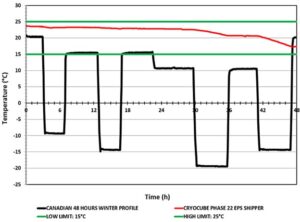
When the subject of cold chain comes up, many people assume that its sole mission is to keep certain products from getting too warm during shipping. In truth, the exact opposite is also an issue that the cold chain industry must address, especially during the colder weather seasons. There are many products that can suffer from freezing, and many options that are available to prevent this.
The Problem of Freezing
Many products that cannot stand overheating also lose value with freezing. Grocery stores cannot sell fresh produce that has been frozen solid. For pharmaceutical companies that ship tissue samples, a frozen sample cannot be properly diagnosed for any serious health issues[i]. For these reasons, shipping temperature-sensitive products during winter weather in the same manner as those shipped during warmer seasons can prove to be disastrous. There is also the issue of logistics that changes during this time of the year. With snowstorms and icy roads, delivery routes may be delayed, increasing the potential for severe temperature deviation.
Planning
The key element to ensuring that your temperature-sensitive shipment does not get too cold during the winter months is planning. Before a product is sent out, check the weather report for both the shipping location and the delivery destination. If there is any indication of a storm or bad road conditions, pad the arrival time of your shipment to allow for delays. Finally, check with your carrier about any alternative routes or transportation if the original mode of delivery fails due to the weather[ii].
Packaging
It is always important to consider what type of packaging to use to keep your product at a specific ideal temperature. Cardboard boxes are affordable while plastic containers block out excess moisture; however, while they may keep your package from freezing, they might also fail to retain the cold that the package needs[iii]. An excellent solution is a container made of expanded polystyrene, or EPS. It provides excellent insulation while protecting the product within. For this shipping solution to work most effectively, it needs the right refrigerant to go with it.
Refrigerants
Many temperature-controlled packages utilize water-based gel packs in their solid state as the primary refrigerant. This means that the gel pack needs to be conditioned well below 0°C to solidify it prior to use, and it can easily freeze the product if placed in direct contact. This results in many designs where water-based gels are also placed as buffers between the product and the frozen gel packs to offset the temperature. This works fine in most situations but has the conceptual weakness of relying on a material that naturally maintains 0°C to keep the product from freezing. For situations where extra protection is needed, a Phase Change Material (PCM) that has a freezing point above the low temperature limit is often utilized.

The temperature profile above is intended to represent a cold weather day in Canada that a small parcel shipment might experience. The PCM can resist the very cold ambient conditions and maintain the temperature of the product payload above the 15°C lower limit. Since the PCM freezes at room temperature, the product also holds room temperature inside the package. The internal measurements show the 22°C phase change temperature being maintained with a simple EPS container around it. Since water does not freeze until it reaches 0°C, it is not well-suited to this sort of application.
Cryopak offers a complete range of shipping solutions and phase change material options to address your temperature control packaging needs. For more information, you can reach us through our website; www.cryopak.com, by email; sales@cryopak.com or by phone; (732) 346-9200.
References
[i] Corn, Rachel. “Winter Shipping Tips.” Kansas State Veterinary Diagnostic Laboratory, October 2018, https://www.ksvdl.org/resources/news/diagnostic_insights_for_technicians/october2018/winter-shipping-tips.html
[ii] “Keys to Winterproofing your Shipping Logistics.” Worldwide Express, https://wwex.com/shipping-resources/general-resources/keys-to-winterproofing-your-shipping-logistics
[iii] “How to prepare and package for temperature-controlled shipping.” FreightQuote, 24 January 2019, https://www.freightquote.com/blog/how-protect-from-freeze-ltl-services-keep-goods-protected/


